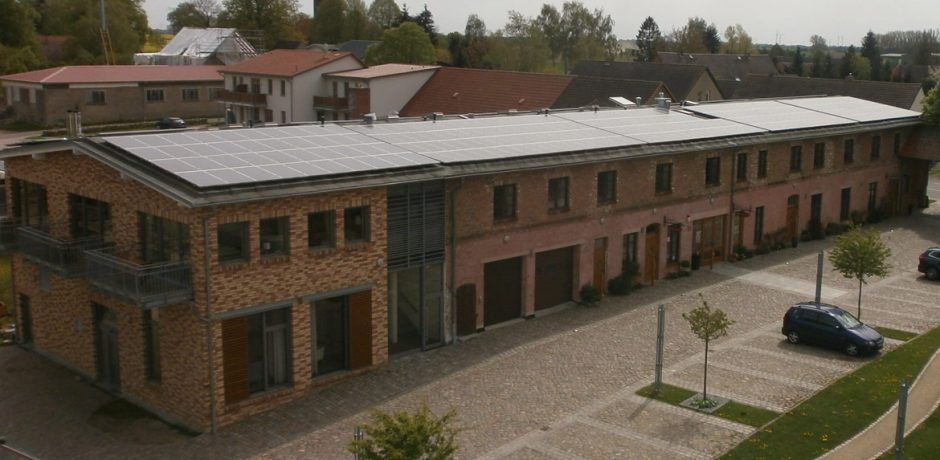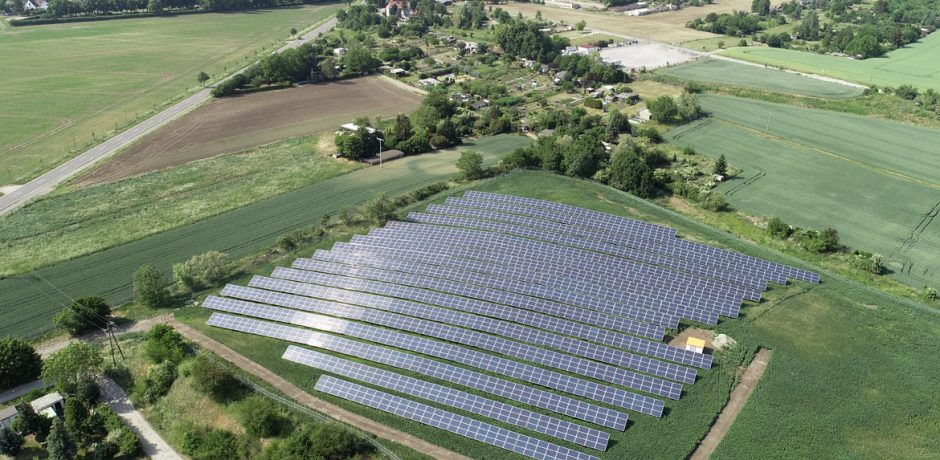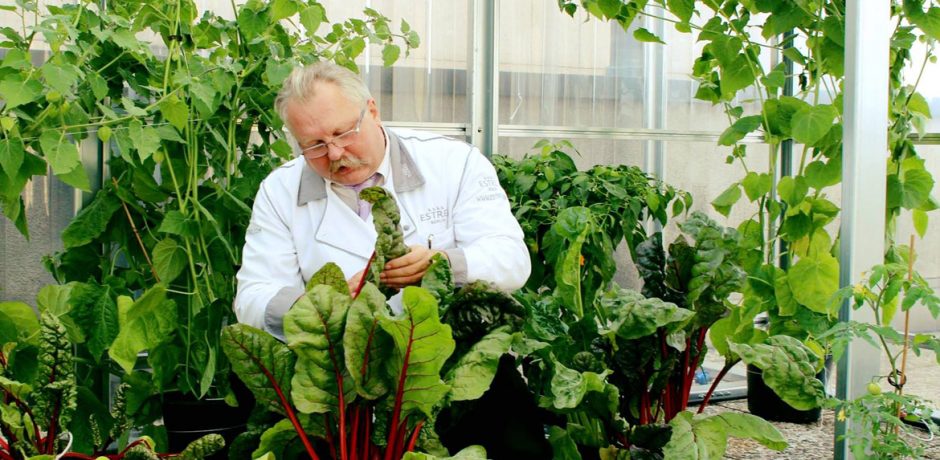Municipalities + agriculture
Energy self-sufficient with SUNfarming solar power
The "Hotel am Peenetal" is the first hotel in Germany that can be operated by renewable energy alone from 2018.
A total of 200 kWp SUNfarming Solar systems provide the 2008 completed complex, including a spa with brine basin and swimming pool, with solar power in the future. Installed 120 kWp on the former cowshed and 80 kWp distributed on 5 carports. An energy concept was established even before the start of construction. In addition to the PV systems, heat is obtained from heat pumps with deep bores. A Eventsaal with 200 seats is heated with floor and wall heating. In principle, only LED lighting is used and an energy-saving technology ensures the water treatment.
"In the future, the hotel will be able to operate with renewable energy alone. This is probably unique for Germany and the project is waiting for imitation, "explains Julius Jäger, SUNfarming project manager.
Unanimous decision for SUNfarming Food & Energy
Local council in Wittingen unanimously votes in the town hall on 30 August for the first joint Food & Energy investment project by SUNfarming and KoNaMo (Competence Network for Sustainable Mobility)
This is another important step towards the realization of the first large SUNfarming oasis for Food & Energy plants in Germany.
The metalworking Butting Group provides almost 3 ha of land in Knesebeck for the construction. The parcel is located directly behind the premises and will be leased to the project. The roofs of the solar greenhouses are partially occupied with PV modules for power generation, the area in the greenhouse under the modules is used for the cultivation of regionally produced food.
KoNaMo is based in Berlin, where actors and strategies, technologies and application scenarios for sustainable mobility in Germany are brought together.
"The Butting GmbH is an optimal project partner for us because the power is 100% accepted on weekends," explains Holger Schönherr SUNfarming project manager.
"With our Food & Energy facilities, we can give around 20 people from crisis areas, long-term unemployed and people with disabilities a chance to qualify for the first job market each year," adds Holger Schönherr.
In addition, managers should also be trained to take care of the operation and the marketing. According to the city council, the company's partners are the Oskar Kämmer School and the Federal Employment Agency.
The SUNfarming Food & Energy Training concept of solar greenhouses has been successfully applied and tested in Africa. South Africa has the best experience with this concept and we want to establish this concept in Germany as well.
The goal is to start construction by the middle of next year.
3.2 million kilowatt-hours of electricity from solar energy
Four more SUNfarming solar parks with a total power of 3,000 kWp solar energy were successfully connected to the grid until the middle of 2018 in Märkisch Oderland and in Saxony-Anhalt.
In the municipalities of Wolmirsleben, Wegeleben and Hennickendorf in Saxony-Anhalt, 750 kWp were ever realised on former landfill sites, a further 750 kWp were completed in Harzgerode in the district of Märkisch Oderland as a free-field plant.
"Every year the four plants together produce proud 3.2 million kilowatt-kilowatts of electricity. This is enough to supply electricity from solar energy for about 900 households over 30 years. 11,000 built-in SUNfarming quality modules ensure a CO2 saving of 1,700 tonnes per year", explains Martin Hinneburg SUNfarming head of sales and project calculation.
Landfills are as sites for Solar Park as created, no shading, conveniently located and the network connection in the immediate vicinity. Administration and municipal policy advocated a leasing of the area and the development of a photovoltaic system since other uses are often not to be reconciled with the context of a former landfill.
In addition to the sustainable generation of energy, the solar parks have additional financial benefits for the counties, which has an impact on the costs of the citizens.
Read more about the SUNfarming Own-Electricity-Concept for municipalities
SUN:BAR Photovoltaic Barnim GmbH plans first PV plant
Joint venture with SUNfarming subsidiary invests in decentralized energy generation plants
The District Council deputies decided it at the March meeting and in June it was legally founded: the SUN:BAR Photovoltaic Barnim GmbH. The project company, a joint venture between the Brandenburg BPG Beteiligungs-und Projekt Management GmbH from Erkner (sister company of SUNfarming GmbH) and the Barnimer Energy Investment Company MBH (BEBG) plans to invest in the Barnim decentralised generation and storage of electricity from renewable energy sources.
The first project is already on the verge of implementation: this year, the expansion of the landfill in Eberswalde will start an energy park. Up to 2020, three solar plants with an installed capacity of 750 kWp are to be built on the site of the decommissioned landfill. The completion of the first plant is already planned for autumn 2018.
"It is our first joint venture with a municipal company and we are pleased to be able to contribute a part to the implementation of the Barnimer energy turnaround," says Martin Tauschke, technical managing director of SUN:BAR.
"With the BPG we have found a competent and experienced partner in the solar plant investment planning and plant management to build municipal production plants in the district Barnim. In perspective, our goal is to market the electricity generated here also regionally. The participation of citizens is also within reach. One of the three plants could be conceived as a citizen solar system, we examine ", announces Christian Mehnert, managing director of SUN:BAR.
SUNfarming solar energy for 1600 households
SUNfarming solar energy for 1600 households
The SUNfarming photovoltaic plants on the former landfill Seelow and Hennickendorf in the district Märkisch Oderland in Germany were officially handed over on 03.11.2017. District administrator Gernot Schmidt and EMO works director Angela Friesse were attending the handing over. The power generated can supply more than 1,600 households with electricity.
Karsten Balzer, authorized signatory of SUNfarming, described the facilities as win-win projects. "Both, SUNfarming and the district Märkisch Oderland, benefit from it. SUNfarming takes over the long-term care and security of the refurbished landfills with the leases that are limited to 27 years, "explained Balzer. The 150,000 m2 landfill site in Hennickendorf, or 39,191 m2 in Seelow, were fenced in for protection. During the construction of the facilities, the properly covered landfill body was not to be damaged. In Seelow a special concrete base was created for this purpose. Both systems are equipped with a remote monitoring system. Faults or damage are reported immediately. Thanks to the support of the district, the construction of the freefield plants was possible, emphasized Balzer.
For the district, the plants have meaning in many ways, said district administrator Gernot Schmidt. "They correspond to the energy concept of the district, where renewable energies are very important," he said. Even today, these energies in the district would generate 130 percent of the electricity needed in households. On the other hand, it would eliminate the care and maintenance costs for the EMO as owner. "And the leasing income benefits the citizen," says Schmidt. For the three landfills covered with SUNfarming solar modules in Wriezen, Hennickendorf and Seelow, these are around 20,000 euros per year, added EMO works director Angela Friesse. The money flows into the fee calculation.
Numbers and facts:
■ Landfill Hennickendorf: 7200 modules, total capacity of 1500 kW. Performance: The plant generates electricity for about 600 households.
■ Landfill Seelow 11 808 modules, total capacity 2460 kW. Performance: The plant in Seelow generates electricity for approx. 1000 households.
Tomatoes from the hotel roof
On the sun terrace of the Estrel in Berlin, the largest hotel in Europe, SUNfarming has built its agro-solar greenhouse
The greenhouse, covered with a 4 m wide light dome, has a size of 42.5m² (5m x 8.5m). The roof tops, east and west of the light dome, are equipped with SUNfarming modules, the generated solar electricity is used directly by the hotel.
The "SF Urban Farming Concept", developed by SUNfarming, produces sustainable solar energy and regional food - on the same place. In addition to the solar power, vegetables, fruits, flowers or fish can be gained between the modules of new or already built PV free-field plants or in special agro-solar Food & Energy greenhouses.
Here, from one of the highest points of the Estrel, Peter Griebel, the kitchen director, not only enjoys a magnificent view over Berlin, but here he is now harvesting herbs, cauliflower, chili, chard and physalis, to mention only a few. Regionally and sustainably produced finesse and highlights for the hotel kitchen.
Learn more about the SUNfarming Urban Farming Concept:
By loading the map, you accept Google's privacy policy.
Learn more









